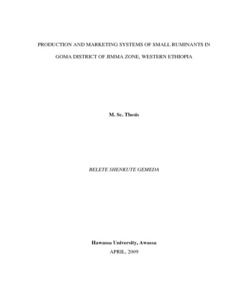Resource information
The study was conducted in Goma district of Jimma Zone of Ethiopia with objectives of generating baseline information and identifying challenges and opportunities of small ruminant production and marketing. Results are based on diagnostic survey of 160 sample households, group discussions, monitoring of 36 flocks and rapid appraisal of major sheep and goat markets. The study district was stratified into three groups based on flock distribution as: sheep dominating, goat dominating and mixed flock sites. The average land holding per household was 1.93 ha. On average, a household owned 3.6 cattle, 3.6 sheep, 2.1 goats, 0.2 equines and 2.7 chickens. In Goma where coffee and chat are the major cash sources for farmers, small ruminant are mainly kept for cash generation and saving in time of coffee failure. About 94% of the small ruminant owners reported to keep them for income generation. The second main reason for keeping small ruminant in the study area was for saving purpose. Keeping small ruminant for manure purpose was the third important reason. Other important reasons included for meat production and for risk distribution. Farmers kept larger proportion of female animals than male animals and it was rare to find male of advanced age as they were sold or slaughtered at early age. Fattening small ruminants is commonly practiced by most farmers and nowadays getting more attention due to high market demand and better prices. From the interviewed households, 59.4%, 32.1, 23.5%, and 19.4% of them utilize communal grazing, after math grazing, roadside grazing, and riverside grazing, respectively. Most small ruminants are either tethered or herded all the seasons due to the cultivation of perennial crops and predators. All small ruminants are housed for protection from adverse weather conditions and predators. Most lambings and kiddings occurred in the main rainy season. The average litter size, birth weight (kg), and weaning weight (kg) of sheep were found to be: 1.37, 2.86 and 11.59, respectively. The corresponding values for goats were 1.6, 2.76, and 9, respectively. There are five towns where small ruminants were marketed in addition to many villages that were used as primary market sources for small ruminants. Farmers, traders, brokers, restaurant/hotel owners, butchers are the major market participants. There is one main market route i.e., from Agaro to Addis. The major problems for small ruminant production and marketing were: feed and grazing land shortage, lack of input, predators, diseases and parasites and marketing problems. In order to utilize the current growing demand of small ruminant meat at local and international markets, identification of alternative feed resources and strategic feeding management, identification of causes of diseases and their control methods as well as improving marketing efficiency through appropriate policy and provision of information are areas of interventions.



